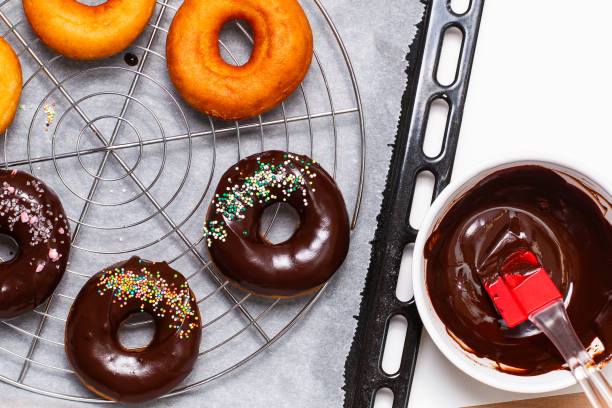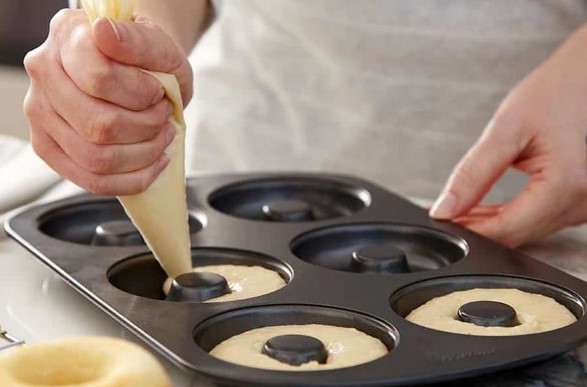In a world where the tantalizing aroma of freshly baked donuts can turn even the most disciplined dieter into a craving connoisseur, the absence of a donut pan should never be a barrier to indulgence.
Picture this: golden rings of pillowy dough, kissed by a glaze so divine it could tempt the most stoic of saints. Fear not, dear culinary adventurer, for I shall unveil the secrets of crafting these delectable delights sans donut pan.
Bid adieu to limitations and embrace the art of donut making with ingenuity and flair. Prepare to embark on a journey where innovation meets tradition, where resourcefulness births culinary masterpieces.
Get ready to tantalize taste buds and astonish guests with homemade donuts that defy convention and transcend expectation.

How To Make Donuts Without A Donut Pan
Not even a donut pan? Not a problem! There are four different ways to make donuts without using a donut pan! Let’s explore each one now.
1. Muffin Pan And Aluminum Foil
Using a muffin pan and aluminum foil is a clever workaround for making donuts without a donut pan. To begin, tear off squares of aluminum foil and shape them into small balls. Place one foil ball into each cup of the muffin tin, ensuring they’re evenly spaced.
Next, lightly grease the foil balls and the inside of each muffin cup to prevent sticking. Prepare your favorite donut batter and fill each muffin cup about two-thirds full with the batter.
Bake the donuts in the oven according to your recipe instructions until they’re golden brown and cooked through. Once baked, allow the donuts to cool slightly before carefully removing them from the muffin tin.
Gently peel away the aluminum foil balls from the bottom of each donut. You’ll be left with perfectly shaped donuts ready to be glazed, coated, or decorated to your liking. This method offers an easy and effective way to achieve donut-shaped treats without the need for a specialized pan.
2. Muffin Pan And Parchment Paper
Using a muffin pan and parchment paper is another excellent method for making donuts without a dedicated donut pan. To start, preheat your oven to the temperature specified in your donut recipe.
Next, cut squares of parchment paper large enough to line each cup of the muffin tin. Press each square into the muffin cups, ensuring the parchment paper extends slightly above the rim to create a barrier for the batter.
Lightly grease the parchment paper to prevent sticking. Then, fill each cup with your prepared donut batter, leaving a small gap at the top to allow for rising during baking. Bake the donuts in the oven according to your recipe instructions until they’re golden brown and cooked through.
Once baked, remove the donuts from the oven and allow them to cool slightly in the muffin tin before transferring them to a wire rack to cool completely. Carefully peel away the parchment paper from each donut to reveal perfectly shaped treats.
You can then glaze, coat, or decorate the donuts as desired. This method offers a convenient way to make donuts without the need for specialty equipment, resulting in delicious homemade treats with minimal effort.
3. Cookie Cutter And Cap
Making donuts using a cookie cutter and a cap is a creative and accessible method that yields perfectly shaped treats. Begin by preparing your favorite donut dough, whether it’s a yeast-raised or cake-style batter.
Once the dough is ready, roll it out on a lightly floured surface to your desired thickness. Then, use a donut-shaped cookie cutter to cut out the donut shapes.
To create the center hole, use a smaller round cookie cutter or the cap from a bottle or jar to cut out the center of each donut. Ensure your cap is clean and lightly floured to prevent sticking.
Once you’ve cut out all your donuts, carefully transfer them to a parchment-lined baking sheet. If necessary, re-roll any leftover dough to cut out more donuts. Fry the donuts in hot oil until they’re golden brown on both sides, flipping them halfway through cooking.
Once cooked, transfer the donuts to a paper towel-lined plate to drain any excess oil. Finally, glaze, coat, or decorate the donuts to your preference. This method allows for customization in both size and shape, resulting in delicious homemade donuts without the need for a specialized pan.
4. Working With What You Have
When you’re in the mood for donuts but lack specialized equipment like a donut pan, you can still satisfy your craving by getting creative with what you have in your kitchen. Start by preparing your favorite donut batter, whether it’s a yeast-based or cake-style dough.
Once the batter is ready, consider the tools you have on hand. If you have a muffin pan, you can simply spoon the batter into the muffin cups, filling them about two-thirds full.
Alternatively, shape the batter into small balls and flatten them slightly to create donut-like discs. Fry these in hot oil until they’re golden brown on both sides, ensuring they’re cooked through.
If you don’t have a muffin pan, you can shape the dough into small rings by hand, ensuring the center is removed to create the classic donut shape. Fry these in batches until they’re golden and cooked through.
Another option is to use a piping bag to squeeze out the dough directly into the hot oil, creating irregular shapes that are equally delicious. Once cooked, drain the donuts on paper towels before glazing, coating, or topping them with your favorite flavors.
This approach demonstrates that with a little ingenuity and improvisation, you can still enjoy homemade donuts without the need for specialized equipment.

What To Expect
When making donuts without a donut pan, there are a few things you can expect:
1. Would They Still Taste Like Donuts?
Yes, even without a traditional donut pan, homemade donuts crafted using alternative methods would still taste like the beloved sweet treats we know and love.
The essence of a donut lies in its dough, which can be fried or baked to achieve a crispy exterior and soft, fluffy interior. Whether hand-shaped, molded in a muffin tin, or piped onto a baking sheet, these homemade creations would retain the signature flavor and texture of classic donuts.
The familiar taste of freshly fried or baked dough, combined with the sweetness of glazes, toppings, or fillings, ensures that these homemade treats would undoubtedly satisfy cravings for delicious donuts, despite their unique shapes and sizes.
2. Would They Still Look Like Donuts?
While homemade donuts crafted without a traditional donut pan may vary in appearance from the classic round-with-a-hole shape, they still maintain the essence of a donut.
Depending on the method used, they may take on different shapes such as irregular rounds, discs, or even elongated forms. Despite these variations, homemade donuts typically retain key visual cues such as a golden-brown exterior, a slightly puffed-up appearance, and often a hole in the center.
Toppings such as glazes, icing, or powdered sugar can also help enhance their donut-like appearance. Although they may not perfectly resemble store-bought or professionally made donuts, homemade variations have a unique charm and authenticity that adds to their appeal.
Ultimately, while they may have different shapes, homemade donuts still possess the inviting look and enticing aroma that make them irresistible treats.
Baked Donut Recipes
Discover the magic of crafting donuts sans the traditional pan! Take your newfound skill for a spin with these enticing baked donut recipes:
- Vanilla Glazed Baked Donuts: Delve into the realm of timeless flavors with this classic treat. Though simple in appearance, its flavor is nothing short of delightful, making it a unanimous choice for satisfying sweet cravings, regardless of age.
- Baked Chocolate Cake Donuts: Elevate your baking game with the indulgent allure of chocolate cake donuts. While some may not fully embrace the richness of chocolate, these treats are bound to win over the younger crowd with their irresistible cocoa-infused goodness.
- Cinnamon Baked Doughnuts: For those seeking a departure from overly saccharine indulgences, venture into the realm of cinnamon-spiced delight. While cinnamon may not be everyone’s cup of tea, if it resonates with your taste buds, this delectable option is tailor-made for you!

Things To Consider
When making donuts without a donut pan, there are several factors to consider to ensure successful results:
Texture
Texture plays a crucial role in the success of homemade donuts, especially when making them without a donut pan. For yeast-raised donuts, achieving the right texture involves creating a dough that is smooth, elastic, and slightly tacky.
This ensures proper rise and a light, airy interior once fried or baked. For cake-style donuts, the batter should be thick yet moist, allowing it to hold its shape when formed and resulting in a tender crumb after cooking.
Adjusting the amount of flour, liquid, and leavening agents can help achieve the desired texture. Moreover, proper kneading or mixing techniques are essential to develop gluten in yeast-raised dough or to evenly distribute ingredients in cake-style batter.
By paying attention to texture and following the recipe closely, you can ensure that your homemade donuts have the perfect consistency for a delightful eating experience.
Cooking Method
When making donuts without a donut pan, the cooking method you choose significantly influences the final texture and flavor of your homemade treats. The two primary methods are frying and baking.
Frying:
Frying donuts typically yields a crispy exterior and a soft, fluffy interior. To fry donuts, heat oil in a deep pan or fryer to the recommended temperature (usually around 350°F or 180°C).
Carefully place the shaped dough into the hot oil, ensuring not to overcrowd the pan. Fry the donuts until they are golden brown on both sides, flipping them halfway through cooking.
Once cooked, transfer the donuts to a paper towel-lined plate to drain any excess oil. Frying provides that classic donut texture and flavor, with a slightly crispy exterior giving way to a tender center.
Baking:
Baking donuts is a healthier alternative that still yields delicious results. To bake donuts, preheat your oven to the temperature specified in your recipe. Lightly grease or line a baking sheet with parchment paper.
Shape the dough into donut rings or other desired shapes and place them on the prepared baking sheet. Bake the donuts in the preheated oven until they are golden brown and cooked through, typically around 10-15 minutes depending on the size and thickness of the donuts.
Baking produces a lighter texture and can be a convenient option if you prefer to avoid frying.
Temperature and Timing
Temperature and timing are critical factors when making donuts without a donut pan, as they directly affect the outcome of your homemade treats. Here’s how to manage them effectively:
- Oil Temperature (for Frying): When frying donuts, maintaining the correct oil temperature is crucial for achieving the desired texture and preventing greasiness. Use a deep-fry thermometer to monitor the oil temperature consistently. For yeast-raised donuts, the oil should be around 350°F (180°C), while cake-style donuts may require slightly lower temperatures. Adjust the heat as needed to keep the oil temperature stable throughout the frying process.
- Oven Temperature (for Baking): When baking donuts, preheat your oven to the temperature specified in your recipe. Ensure that your oven is accurately calibrated to prevent under or overcooking. Invest in an oven thermometer to verify the accuracy of your oven’s temperature. Consistent and precise oven temperature is crucial for achieving evenly baked donuts with golden exteriors and tender interiors.
- Cooking Time: Timing is key to ensuring that your donuts are cooked through without becoming overdone. Whether frying or baking, follow the recommended cooking times provided in your recipe as a guideline. Keep an eye on your donuts as they cook and adjust the cooking time if necessary. Factors such as the size and thickness of the donuts, as well as variations in oven performance or oil temperature, may affect the cooking time.
Handling and Shaping
Handling and shaping the dough properly is crucial when making donuts without a donut pan to ensure they maintain their shape and texture during cooking. Here’s how to handle and shape the dough effectively:
- Prepare Work Surface: Begin by lightly flouring your work surface to prevent the dough from sticking. If you’re rolling out the dough, ensure the surface is clean and smooth to facilitate easy shaping.
- Shaping: Depending on your preferred method, shape the dough into donut rings, balls, or other desired shapes. For traditional donut shapes, roll out the dough into a circle and use a donut cutter or two differently sized round cutters to create the outer ring and center hole. Alternatively, you can shape the dough into balls and flatten them slightly to create donut discs.
- Uniformity: Aim for uniformity in size and thickness to ensure even cooking. This will help your donuts cook evenly and maintain a consistent texture throughout.
- Be Gentle: Handle the dough gently to avoid overworking it, which can result in tough or dense donuts. Use a light touch when shaping and transferring the dough to prevent deflating it.
- Use Tools: If shaping by hand, consider using tools like round cutters or the rim of a glass to create uniform shapes. This can help achieve consistent results, especially if you’re making a large batch of donuts.
- Support: Support the donuts carefully when transferring them to the frying pan or baking sheet to maintain their shape. Use a spatula or slotted spoon to lift and transfer the donuts without distorting them.
By following these handling and shaping tips, you can create beautifully formed homemade donuts that are as visually appealing as they are delicious. Practice and patience will help you master the art of shaping donuts without a donut pan.

Customization
Customization is a fun and creative aspect of making donuts without a donut pan, allowing you to tailor your homemade treats to your taste preferences and dietary needs. Here are some ways you can customize your donuts:
- Flavor Variations: Experiment with different flavors for your donut dough, such as vanilla, chocolate, cinnamon, or citrus. Add ingredients like cocoa powder, spices, or extracts to infuse unique flavors into the dough.
- Toppings and Fillings: Get creative with toppings and fillings to enhance the flavor and texture of your donuts. Dip them in glazes, such as classic sugar glaze, chocolate ganache, or flavored icing. Alternatively, roll them in powdered sugar, cinnamon sugar, or chopped nuts. Consider filling donuts with jam, custard, cream cheese, or Nutella for added decadence.
- Decorations: Add decorative elements to your donuts to make them visually appealing. Sprinkle them with colorful sprinkles, crushed cookies, shredded coconut, or edible flowers. Drizzle them with melted chocolate, caramel, or fruit coulis for an elegant finishing touch.
- Shape Varieties: Experiment with different shapes and sizes for your donuts. Instead of traditional rings, try making donut holes, twists, or even novelty shapes using cookie cutters or molds.
- Healthier Options: Modify your donut recipe to make healthier versions by using whole grain flour, reducing sugar content, or incorporating ingredients like Greek yogurt, applesauce, or mashed banana for moisture and sweetness.
- Seasonal Themes: Celebrate holidays or special occasions by customizing your donuts with seasonal flavors and decorations. For example, add pumpkin spice and a cream cheese glaze for fall, or decorate with red and green sprinkles for Christmas.
Customizing your homemade donuts allows you to express your creativity and personalize your treats according to your preferences. Whether you prefer classic flavors or innovative combinations, there are endless possibilities to create delicious and unique donuts that will delight your taste buds.
Presentation
Presentation is an essential aspect of serving homemade donuts without a donut pan, as it adds to the overall appeal and enjoyment of these delightful treats. Here are some tips for presenting your homemade donuts:
- Arrangement: Arrange your donuts neatly on a serving platter or tray. Consider grouping them together by flavor or decoration for an organized and visually appealing display.
- Colorful Garnishes: Add colorful garnishes to enhance the visual appeal of your donuts. Sprinkle them with vibrant sprinkles, chopped nuts, or edible flowers to add pops of color and texture.
- Drizzles and Decorations: Drizzle your donuts with decadent toppings such as melted chocolate, caramel sauce, or fruit glaze. Use a piping bag or spoon to create decorative patterns or designs for an elegant finishing touch.
- Variety: Offer a variety of flavors and toppings to cater to different tastes and preferences. Display an assortment of glazed, filled, and decorated donuts to provide options for your guests to choose from.
- Seasonal Themes: Celebrate special occasions or holidays by incorporating seasonal themes into your donut presentation. Decorate your donuts with festive colors, shapes, and decorations to complement the occasion.
- Serve with Accompaniments: Consider serving your donuts with complementary accompaniments such as coffee, hot chocolate, or flavored milk. Provide dipping sauces or spreads for additional flavor options.
- Elevate with Props: Use props such as cake stands, decorative plates, or themed napkins to elevate the presentation of your homemade donuts. Create an inviting display that entices guests to indulge in these delicious treats.
By paying attention to presentation details, you can transform your homemade donuts into an eye-catching and irresistible dessert that will impress your guests and make any occasion extra special.

Frequently Asked Questions (FAQs) – Making Donuts Without a Donut Pan
Q: Can I really make donuts without a donut pan?
A: Absolutely! With a little creativity and resourcefulness, you can whip up delicious donuts using alternative methods and tools you likely already have in your kitchen.
Q: What are some alternatives to a traditional donut pan for making donuts?
A: You can use muffin tins, cookie cutters, or even shape them by hand. These alternatives offer versatility and allow you to customize the size and shape of your donuts.
Q: Will my donuts turn out just as good without a donut pan?
A: Definitely! Making donuts without a donut pan opens up opportunities for experimentation and innovation. Your homemade donuts may even have a unique charm and character that sets them apart.
Q: Are there any special tips for making donuts without a donut pan?
A: Yes! One tip is to ensure your dough is the right consistency for shaping. You can also use parchment paper or silicone molds to help maintain the shape of your donuts during baking.
Q: Can I still achieve that classic donut shape without a donut pan?
A: Absolutely! While your donuts might not have the perfectly uniform shape of store-bought ones, they’ll still be delicious and visually appealing. Embrace the homemade charm!
Q: Is it difficult to make donuts without a specialized pan?
A: Not at all! Making donuts without a donut pan can be a fun and rewarding culinary adventure. Plus, you’ll feel a sense of accomplishment knowing you created something delicious from scratch.
Q: Can I involve my kids in making donuts without a donut pan?
A: Absolutely! Making donuts without a donut pan is a great family activity. Children can help shape the dough, choose toppings, and get creative with decorations, fostering valuable culinary skills and cherished memories.
Q: Are there any benefits to making donuts without a donut pan?
A: Definitely! By forgoing a donut pan, you’re encouraged to think outside the box and explore alternative methods of baking. This can lead to greater creativity and innovation in the kitchen.
Q: Will making donuts without a donut pan save me money?
A: Absolutely! Utilizing items you already have in your kitchen means you won’t need to invest in a specialized pan. Plus, homemade donuts are generally more cost-effective than store-bought ones.
Q: Can I still enjoy a wide variety of flavors and toppings with homemade donuts?
A: Of course! Making donuts without a donut pan allows you the freedom to experiment with an endless array of flavors, glazes, and toppings. Let your imagination run wild and create donuts that suit your unique tastes and preferences.
Conclusion
In conclusion, mastering the art of making donuts without a donut pan opens up a world of possibilities for home bakers.
By utilizing alternative methods such as piping or shaping the dough by hand, individuals can achieve delicious and visually appealing results with minimal equipment.
Experimenting with different flavors, fillings, and toppings allows for endless creativity, ensuring that every batch of homemade donuts is unique and satisfying.
With a little ingenuity and patience, anyone can enjoy the delightful experience of crafting their own donuts, even without a specialized pan.
So, roll up your sleeves, preheat the oven, and embark on a journey of sweet indulgence that promises to delight taste buds and bring joy to all who partake.
Other Articles You May Also Like: